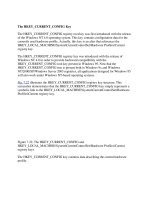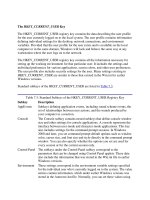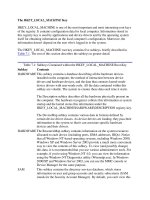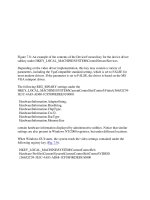Tài liệu The HKEY_CURRENT_USER Key doc
Bạn đang xem bản rút gọn của tài liệu. Xem và tải ngay bản đầy đủ của tài liệu tại đây (17.37 KB, 3 trang )
The HKEY_CURRENT_USER Key
The HKEY_CURRENT_USER registry key contains the data describing the user profile
for the user currently logged on to the local system. The user profile contains information
defining individual settings for the desktop, network connections, and environment
variables. Provided that the user profile for the user exists and is available on the local
computer or in the same domain, Windows will look and behave the same way at any
workstation where the user logs on to the network.
The HKEY_CURRENT_USER registry key contains all the information necessary for
setting up the working environment for that particular user. It includes the settings and
individual preferences for various applications, screen colors, and other user preferences.
The user profile also includes security settings for the user. Many settings existing in
HKEY_CURRENT_USER are similar to those that existed in the Win.ini for earlier
Windows versions.
Standard subkeys of the HKEY_CURRENT_USER are listed in Table 7.3
.
Table 7.3: Standard Subkeys of the HKEY_CURRENT_USER Registry Key
Subkey Description
AppEvents Subkeys defining application events, including sound scheme events, the
set of relationships between user actions, and the sounds produced by
your computer as a reaction.
Console The Console subkey contains nested subkeys that define console window
size and other settings for console applications. A console represents the
interface between user-mode and character-mode applications. This key
also includes settings for the command prompt sessions. In Windows
2000 and later, you set command prompt default options-such as window
color, cursor size, and font size and style-directly in the command prompt
window. You can also specify whether the options you set are used for
every session or for the current session only.
Control Panel The subkeys under the Control Panel subkey correspond to the
parameters that can be changed using Control Panel applets. These data
also include the information that was stored in the Win.ini file in earlier
Windows versions.
Environment These settings correspond to the environment variable settings specified
for the individual user who's currently logged on to the system. The value
entries contain information, which under earlier Windows versions was
stored in the Autoexec.bat file. Normally, you can set these values using
Table 7.3: Standard Subkeys of the HKEY_CURRENT_USER Registry Key
Subkey Description
Control Panel applets.
Keyboard
Layout
The subkeys under this key specify the national language used for Layout
the current keyboard layout.
Printers The subkeys under this key describe currently installed printers that are
available for the user currently logged on to the system. To change these
settings, click the Start button, then select Settings | Printers.
Software This key contains subkeys that describe configuration settings for the
software installed on the local computer and available to the user who's
currently logged on to the system. This information has the same
structure as the HKEY_LOCAL_MACHINE\Software registry key. The
information also includes application-specific data that was previously
stored in the Win.ini file or in application-specific INI files.
UNICODE
Program
Groups
This key is provided for backward compatibility. It wasn't used in
Windows NT 4.0. If your system was upgraded from earlier versions of
the Windows NT operating system (for example, from Windows NT 3.51
to Windows NT 4.0), this key may contain some subkeys inherited from
the previous versions and store binary data. However, neither this key nor
its subkeys contain any data needed by Windows NT 4.0/Windows 2000
or Windows XP/Windows Server 2003.
Windows 3.1
Migrations
Status
This key will contain data only if you've upgraded your operating system
from an earlier Windows version (for example, from Windows 3.x to
Windows NT 4.0). The subkeys present within this key specify whether
the process of upgrading program group files (GRP files) and
initialization files (INI files) has completed successfully. If you delete
this key, Windows will attempt the conversion next time you reboot the
system.
Note that the Windows 3.1 Migration Status subkey also exists within the
HKEY_LOCAL_MACHINE\Software key.
As I mentioned earlier in the section dedicated to the HKEY_LOCAL_MACHINE root
key, the HKEY_CURRENT_USER data normally has priority over similar data existing
under HKEY_LOCAL_MACHINE. For example, let's look at how this convention works
for environment variables. The environment variable settings defined for the currently
logged on user have priority over the system environment variables (use the System
applet in Control Panel to set environment variables).
The HKEY_CURRENT_USER key references the HKEY_USERS\<SID_#> registry
key, where the <SID_#> is a string containing the security identifier (SID) of the user
who's currently logged on to the system. The logon process creates the user profile
environment based on the data found under the HKEY_USERS\<SID_#>. If this data is
unavailable, the HKEY_CURRENT_USER is built based on the data contained in the
%SystemRoot%\Profiles\Default User\Ntuser.dat file (Windows NT 4.0) or in the
%SystemRoot%\Documents and Settings\Default User\Ntuser.dat file (Windows 2000
and later versions).
Note To find the file supporting the registry hive, view the HiveList subkey under the
HKEY_LOCAL_MACHINE\System\CurrentControlSet\Control key. To find
the user profile hive (whether or not this user is currently logged on), view the
ProfileList subkey under the
HKEY_LOCAL_MACHINE\Software\Microsoft\Windows NT\CurrentVersion
key.









